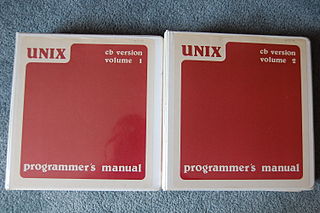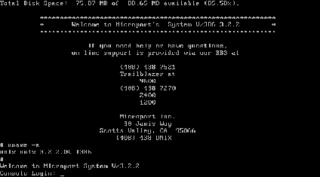 W
WCaldera International, earlier Caldera Systems, was an American software company that existed from 1998 to 2002 and developed and sold Linux- and Unix-based operating system products.
 W
WColumbus UNIX, or CB UNIX, is a discontinued variant of the UNIX operating system used internally at Bell Labs for administrative databases and transaction processing. It was developed at the Columbus, Ohio branch, based on V6, V7 and PWB Unix. It was little-known outside the company.
 W
WThe Common Open Software Environment (COSE) was an initiative formed in March 1993 by the major Unix vendors of the time to create open, unified operating system (OS) standards.
 W
WThe Computer Systems Research Group (CSRG) was a research group at the University of California, Berkeley that was dedicated to enhancing AT&T Unix operating system and funded by Defense Advanced Research Projects Agency.
 W
WThe history of Unix dates back to the mid-1960s when the Massachusetts Institute of Technology, AT&T Bell Labs, and General Electric were jointly developing an experimental time-sharing operating system called Multics for the GE-645 mainframe. Multics introduced many innovations, but had many problems.
 W
WMicroport (1985–2002) was a software development group that pioneered a new approach towards software ports that dramatically reduced development costs and, consequently, the price charged for UNIX. Microport created the first ports of AT&T's UNIX System V for the IBM 286 and 386 personal computers, as well as IBM's PS/2 systems. Microport was critical to enabling the Free Software Foundation (FSF) to port its GNU C compiler (gcc) and associated utilities, onto the x86 architecture by donating a complete 386 development system to the Richard Stallman-led group. Microport also played a key role in Kevin Mitnick's first arrest, after he broke into the internal computer networks of both Microport and The Santa Cruz Operation.
 W
WOPEN LOOK is a graphical user interface (GUI) specification for UNIX workstations. It was originally defined in the late 1980s by Sun Microsystems and AT&T Corporation.
 W
WProject Monterey was an attempt to build a single Unix operating system that ran across a variety of 32-bit and 64-bit platforms, as well as supporting multi-processing. Announced in October 1998, several Unix vendors were involved; IBM provided POWER and PowerPC support from AIX, Santa Cruz Operation (SCO) provided IA-32 support, and Sequent added multi-processing (MP) support from their DYNIX/ptx system. Intel Corporation provided expertise and ISV development funding for porting to their upcoming IA-64 CPU platform, which was yet to be released at that time. The focus of the project was to create an enterprise-class UNIX for IA-64, which at the time was expected to eventually dominate the UNIX server market.
 W
WSCO Forum was a technical computer conference sponsored by the Santa Cruz Operation (SCO), briefly by Caldera International, and later The SCO Group that took place during the 1980s through 2000s. It was held annually, most often in August of each year, and typically lasted for much of a week. From 1987 through 2001 it was held in Santa Cruz, California, on the campus of the University of California, Santa Cruz. The scenic location, amongst redwood trees and overlooking Monterey Bay, was considered one of the major features of the conference. From 2002 through 2008 it was held in Las Vegas, Nevada, at one of several hotels on the Las Vegas Strip. Despite the name and location changes, the conference was considered to be the same entity, with both the company and attendees including all instances in their counts of how many ones they had been to.
 W
WThe Software Tools Users Group (STUG) was a technical organization started in 1976, in parallel with Usenix. The STUG goal was to develop a powerful and portable Unix-like system that could be implemented on top of virtually any operating system, providing the capabilities and features of Unix in a non-proprietary system. With its focus on building clean, portable, reusable code shared amongst multiple applications and runnable on any operating system, the Software Tools movement reestablished the tradition of open source and the concepts of empowering users to define, develop, control, and freely distribute their computing environment.
 W
WSpace Travel is an early video game developed by Ken Thompson in 1969 that simulates travel in the Solar System. The player flies their ship around a two-dimensional scale model of the Solar System with no objectives other than to attempt to land on various planets and moons. The player can move and turn the ship, and adjust the overall speed by adjusting the scale of the simulation. The ship is affected by the single strongest gravitational pull of the astronomical bodies.
 W
WUnivel, Inc. was a joint venture of Novell and AT&T's Unix System Laboratories (USL) that was formed in October 1991 to develop and market the Destiny desktop Unix operating system, which was released in 1992 as UnixWare 1.0. Univel existed only briefly in the period between AT&T initially divesting parts of USL in 1991, and its eventual outright purchase by Novell, which completed in 1993, thereby acquiring rights to the Unix operating system. Novell merged USL and Univel into their new Unix Systems Group (USG).
 W
WUnix System Laboratories (USL), sometimes written UNIX System Laboratories to follow relevant trademark guidelines of the time, was an American software laboratory and product development company that existed from 1989 through 1993. At first wholly, and then majority, owned by AT&T, it was responsible for the development and maintenance of one of the main branches of the Unix operating system, the UNIX System V Release 4 source code product. Through Univel, a partnership with Novell, it was also responsible for the development and production of the UnixWare packaged operating system for Intel architecture. In addition it developed Tuxedo, a transaction processing monitor, and was responsible for certain products related to the C++ programming language. USL was based in Summit, New Jersey, and its CEOs were Larry Dooling followed by Roel Pieper.
 W
WThe Unix wars were the struggles between vendors of the Unix computer operating system in the late 1980s and early 1990s to set the standard for Unix thenceforth.
 W
WThe UNIX-HATERS Handbook is a semi-humorous edited compilation of messages to the UNIX-HATERS mailing list. The book was edited by Simson Garfinkel, Daniel Weise and Steven Strassmann and published in 1994.
 W
WSixth Edition Unix, also called Version 6 Unix or just V6, was the first version of the Unix operating system to see wide release outside Bell Labs. It was released in May 1975 and, like its direct predecessor, targeted the DEC PDP-11 family of minicomputers. It was superseded by Version 7 Unix in 1978/1979, although V6 systems remained in regular operation until at least 1985.
 W
W